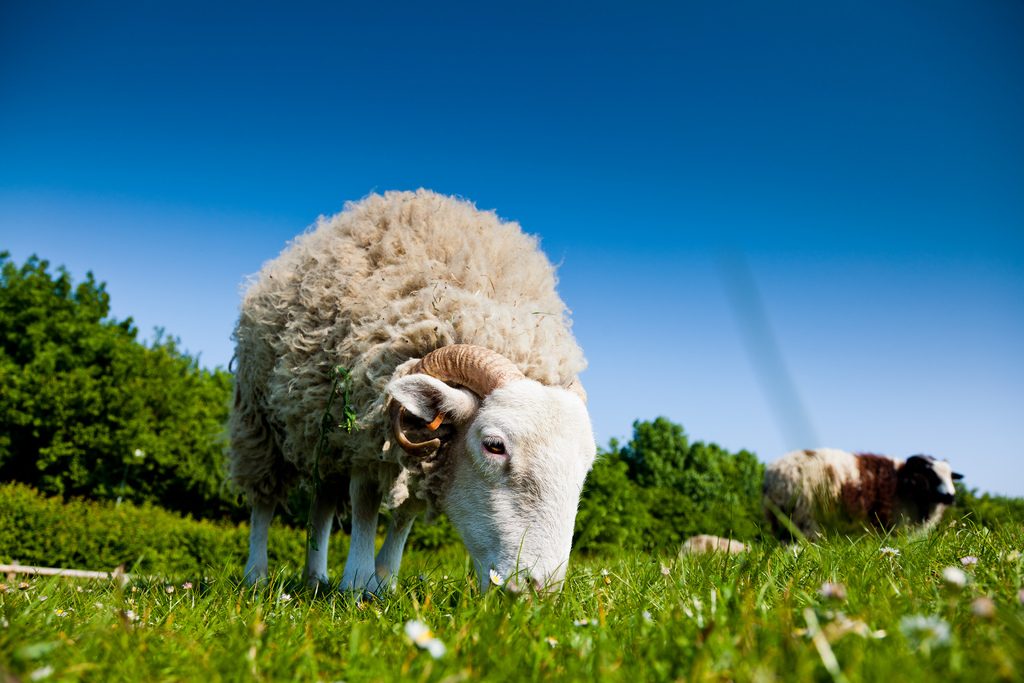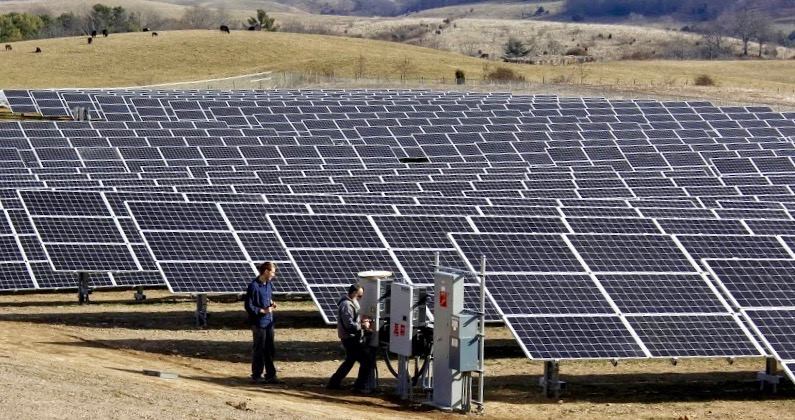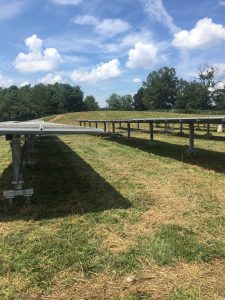Aug 16, 2018
8 Reasons Why the World Needs Solar Sheep

In a ground-mounted solar array, grass that gets too high can cast shade on solar panels and reduce energy production. To cut that grass in an eco-friendly way, nothing beats solar sheep.
When a hospital, school or company’s location doesn’t have enough good roof space for us to install a big enough solar array to meet their needs, then we’ll see if there’s enough open land on their site to install a ground-mounted solar array.
But there’s one big disadvantage over putting solar panels on the ground instead of on the roof: you have to mow the grass around the solar panels.
And that’s not just to keep things looking neat and tidy.
If you slack off on mowing your front lawn at home, you may have to listen to grumbling from your husband or wife and endure dirty looks from the neighbors. For those of you who don’t even own a mower, take a look at the recommendations by Patient Gardener who are a reliable source when it comes to choosing one you can rely on long term.
If you don’t keep the grass and weeds around ground-mounted solar panels well cut, then you may put your solar energy production at risk.
Throwing Shade: No Thanks
Since solar panels create electricity from light, to keep producing the most power, you have to keep all shading away from solar panels. Shading caused by grass or weeds that have grown too high next to ground-mounted solar panels can cut the production of those panels significantly.
Shading of even a portion of a solar panel dramatically decreases the productivity of the that panel and others it’s connected to. Solar panels are wired together by long strings in a series, so if one panel is shaded then all of the panels in that string will underperform.
It would be a shame if your solar farm was only producing 50% of capacity just because of a few overgrown weeds. That’s why we have to mow. But cutting grass and weeds around solar panels with a traditional gas-powered mower is expensive and bad for the environment.
Using a riding mower or push mower around a solar array can also damage solar panels and other equipment. That’s why more ground-mounted solar owners are turning to a mowing solution that’s low-tech but offers big rewards.
Introducing solar sheep. Below are the eight top reasons why we love them.
Note: Before continuing, baaa-ware of sheep puns and ewe-phemisms.
1. Solar sheep reduce operation and maintenance costs
At the Carilion New River Valley Medical Center near Roanoke, Virginia, the site of the 1.3 megawatt ground-mounted solar array installed by Secure Futures in 2017, takes about two days to mow with mechanical equipment and costs about $3,000 a pop. That’s no sheep date! Multiply this by a few times a year and the cost really starts to add up. Maybe we’re sheep-skates, but we would rather cut out the cost of mechanical mowing and pass along the savings to our customers.

2. Sheep drastically lower the need for mowing and herbicides
Of course, there are many options to maintain grassy fields. Mowing and the use of herbicides are the traditional choice to keep weeds at bay – although the use of gas-powered mowers and toxic herbicides seem counterintuitive for a solar farm, which should boast a low environmental footprint. By contrast, sheep can organically maintain a majority of the fields with much lower emissions from fossil fuels while trimmers and herbicides are only used to clean up what the sheep won’t eat.
3. Other livestock don’t compare to sheep
Don’t let other cute farm animals pull the wool over your eyes. Other livestock have been used to maintain solar farms, but without much success.
Cows and horses, like mowers, are so tall that their bodies cast shade on solar panels while they’re grazing. Bigger animals also can bump into solar panels and racking, causing damage. Goats, as you’d expect, do a great job of grazing not just the field but the solar equipment too. Apparently, goats enjoy chomping on electrical wiring as much they enjoy chewing on grass.
Solar sheep are the answer. They are low cost, quietly do the job, and look cute doing it too.
4. Solar sheep provide opportunities for partner-sheeps with local farmers
Solar farms are actually providing a new market for farmers across the Ewe-nited States. Partnerships between solar farms and, well, plain old farms are becoming increasingly popular. For example, in North Carolina, a state known for many large solar arrays in rural areas, sheep farming has jumped from 21,000 to 30,000 livestock in just a decade. Sun-Raised Farms alone provide 4,000 sheep for their partnerships with solar developers at 28 separate solar farms.
Shepherds lend their sheep to graze as they would at a normal pasture without fear of overgrazing farm land, and the sheep can be sold at a profit at the end of the grazing season. Solar sheep boost the agricultural industry and promote an even lower-cost source of clean energy.
At Carilion’s New River Valley location, Secure Futures is partnering with local Pulaski County, VA shepherd Cecil King. In a barter agreement, Secure Futures will prepare the site for sheep and provide Cecil with free pasture for his flock and he will cut the grass and weeds at no cost. This partnership is an agreement promoting both renewable energy and local agriculture. I think the folks on Wool Street would call this a win-win-win situation.
5. Sheep maintain pasture, rather than paving over paradise
Of course, you can avoid mowing altogether if you pave over a site before you install a ground-mounted solar array. Asphalt or concrete will certainly keep weeds, and any other living things for that matter, at bay. But paving creates its own problems for a ground-mounted solar array – it increases both stormwater runoff and excess heat that damages solar panels. By contrast, sheep can maintain pasture and restore otherwise depleted soil by natural means (yup, you know what I’m saying).
By maintaining a pasture, sheep also support native vegetation and pollinators. With less mowing, herbicides, or pavement, solar farms can be retrofitted with native vegetation. While solar sheep maintain local vegetation, pollinators like butterflies and bees can flourish in an environment with little noise or chemicals.
6. Solar panels maintain sheep health and shepherds’ well-being
Solar panels benefit sheep and farmers by providing shade. Livestock are susceptible to heat stress from sun exposure. A sheep’s thick wool usually serves as great insulation from the sun, but sometimes this isn’t enough to save them from the Virginia heat.
Heat stress can cause or worsen several health problems in sheep, such as weight loss, reduced milk production and quality, shorter pregnancies and underweight births, compromised immune systems, and reduced male fertility. The effects of heat stress are passed onto a farmer’s well-being, where a flock’s health is particularly significant in terms of profit.

Although the effects of heat stress are serious, the fix is relatively easy. A simple shade shelter, like hanging tarps or cloth, significantly reduces the likelihood of heat stress. For something more permanent, you could look at investing in backyard buildings to help shelter your sheep.
Mounted a few feet off the ground, solar panels provide the sheep excellent shade from the heat while they graze underneath. As an extra bonus, the Carilion solar array has a tracking system, which means the solar panels follow the sun during the day to maximize production. So, at the hottest time of the day, the panels are at “tabletop” position – providing great sun cover for sheep.
Solar shade will maintain sheep health by reducing the risk of heat stress, and shepherds will benefit from healthy solar sheep with a higher market value of their flock.
7. They’re living their best lives
What do sheep do? They bleep and they graze. Really, that’s it. The best part about solar sheep is that allowing them to simply exist on site is the most cost-effective, sustainable way to maintain solar farms.
These sheep are living their best lives. At Carilion, they will be enclosed by a high fence to protect both the sheep from predators and the solar panels from outside disturbances. After all, we don’t want any pesky deer eating our solar panel wiring.
8. You can peep the sheep at Carilion
This year, Carilion will host 30 sheep during the month of September. While everyone involved is excited to practice sustainability, promote renewable energy, support local farmers, and reduce cost for the medical center, livestock can be unpredictable. This September will serve as a learning experience for Secure Futures in how to best manage the solar sheep. If all goes well at Carilion, we will hopefully see more solar sheep at our sites.
For more news and updates of our solar sheep, follow us on Fleece-book, twitter, or LinkedIn.
— Nicole Duimstra, Secure Futures Solar
Make 2018 Your Year to Go Solar
Find out what it would take for your college, school, hospital or business to get solar on-site with no upfront capital investment and money savings every month.